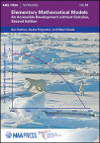- About MAA
- Membership
- MAA Publications
- Periodicals
- Blogs
- MAA Book Series
- MAA Press (an imprint of the AMS)
- MAA Notes
- MAA Reviews
- Mathematical Communication
- Information for Libraries
- Author Resources
- Advertise with MAA
- Meetings
- Competitions
- Programs
- Communities
- MAA Sections
- SIGMAA
- MAA Connect
- Students
- MAA Awards
- Awards Booklets
- Writing Awards
- Teaching Awards
- Service Awards
- Research Awards
- Lecture Awards
- Putnam Competition Individual and Team Winners
- D. E. Shaw Group AMC 8 Awards & Certificates
- Maryam Mirzakhani AMC 10 A Awards & Certificates
- Two Sigma AMC 10 B Awards & Certificates
- Jane Street AMC 12 A Awards & Certificates
- Akamai AMC 12 B Awards & Certificates
- High School Teachers
- News
You are here
Elementary Mathematical Models: An Accessible Development Without Calculus

Buy Now:
Publisher:
AMS
Publication Date:
2019
Number of Pages:
509
Format:
Hardcover
Edition:
2nd
Series:
AMS/MAA Textbooks
Price:
75.00
ISBN:
978-1-4704-5001-4
Category:
Textbook
The Basic Library List Committee suggests that undergraduate mathematics libraries consider this book for acquisition.
[Reviewed by , on ]
Tom G. Schulte
10/20/2019
The preface to this second edition outlines the target audience of this textbook:
EMM is intended to serve the same students as traditional college algebra, liberal arts mathematics, and quantitative literacy courses. These are students who have studied at least a year of algebra in high school, but who are not headed for calculus. They may need to take a mathematics course for a general education requirement. They may also need familiarity with the main ideas of college algebra for quantitative general education courses in areas outside of mathematics, such as science, economics, and business. For most of these students this will be the only mathematics course completed in college.
Further, compared to the first edition there are significant content changes. This edition
…is a reboot. …almost the entire text has been rewritten, with updated examples and a greater emphasis on genuine applications using real data.
Derivation of the linear regression formula was excised along with other algebra fundamentals. An added unit on deriving the family of continuous logistic growth functions from a modified discrete logistic growth difference equation augments nicely coverage on this important, practical family of models. The result is a coherent overview of growth models each derived from difference equations (both linear and nonlinear) with guided approaches in trial-and-error and incremental, motivated improvements on these model families:
- Arithmetic
- Quadratic
- Geometric
- Mixed Growth
- Logistic
The chapter-length survey of logistic growth models is much greater than the coverage in general texts at this level. Generally, I find the introduction in such texts woefully lacking. Significant material here can be used to enhance that, including potential group projects. While “designed as a three-credit-hour course extending over a semester with 14-weeks of instruction”, it is easy to envision all or part of this text augmenting a four-credit-hour introductory course in business or even a hard science. Similarly, there is plenty here for lectures or classroom capsules in other basic, applied courses. One such potential lecture-enlivening capsule is “More About e” introducing numerical methods concepts by describing Euler’s work with his eponymous constant. Another is the ten or so pages on various payoff strategies for the same loan.
Presuming only a background of exposure to high school algebra, the text introduces students to a cogent methodology of mathematical modeling building up from raw, sequential data and employing difference and ratio equations. Sequences lead off in an effective and engaging manner. The reader is drawn easily into a working knowledge ramping up through number patterns in visual and instructive puzzles. Real-world examples abound with multiple contemporary environmental and life science topics: sea ice extent, atmospheric carbon dioxide, infectious disease spread, repeated medication doses, and more. These emphasize the power and utility of quantitative methods which is the aim here, rather than a rigorous, technical mastery. Encompassing a wide spectrum of quantitative models and touching on chaos theory, this is a broad and coherent introduction to basic, predictive data modeling.
A public web site houses ancillary resources for Elementary Mathematical Models. This includes a technology guide covering spreadsheets, calculators, web-based apps, Excel files, and errata. The use of technology is consistently encouraged throughout the text. For Instructors, additional resources available through the AMS (and so inaccessible to students) include a detailed instructor’s guide, exams, clicker questions, and many tips and comments specific to individual sections of the text.
Tom Schulte lives and bicycles in Louisiana and teaches mathematics online for ECPI and Upper Iowa universities.
See the publisher's web page.
- Log in to post comments




